Assessing the Ecosystem Health of Large Drinking-Water Reservoirs Based on the Phytoplankton Index of Biotic Integrity (P-IBI): A Case Study of Danjiangkou Reservoir
Abstract
:1. Introduction
2. Materials and Methods
2.1. Study Area
2.2. Sample Collection and Determination
2.3. Data Collation and Analysis
2.3.1. Dominance and Diversity Index
2.3.2. Comprehensive Trophic Status Evaluation of Water Quality
2.3.3. P-IBI Establishment in Danjiangkou Reservoir
2.3.4. Statistical Analysis
3. Results
3.1. Environmental Characteristics
3.2. Characteristics of Phytoplankton Community Structure in Danjiangkou Reservoir
3.3. Establishment of P-IBI in Danjiangkou Reservoir
3.4. Water Quality Condition Based on P-IBI
3.5. Relationship between P-IBI and Environmental Factors
4. Discussion
4.1. Community Structure of Phytoplankton
4.2. P-IBI Spatial and Temporal Variation
4.3. Influencing Factors Driving P-IBI
5. Conclusions
Supplementary Materials
Author Contributions
Funding
Institutional Review Board Statement
Informed Consent Statement
Data Availability Statement
Acknowledgments
Conflicts of Interest
References
- Cao, X.; Ji, Z.; Lan, H.; Liu, H.; Qu, J. Eutrophication control of lake/reservoir water sources and assurance of drinking water safety in China considering global climate change. Chin. Eng. Sci. 2022, 24, 34–40. [Google Scholar]
- Paul, B.; Bhattacharya, S.S.; Gogoi, N. Primacy of ecological engineering tools for combating eutrophication: An ecohydrological assessment pathway. Sci. Total Environ. 2021, 762, 143171. [Google Scholar] [PubMed]
- Glibert, P.M. Eutrophication, harmful algae and biodiversity—Challenging paradigms in a world of complex nutrient changes. Mar. Pollut. Bull. 2017, 124, 591–606. [Google Scholar]
- Heisler, J.; Glibert, P.M.; Burkholder, J.M.; Anderson, D.M.; Cochlan, W.; Dennison, W.C.; Dortch, Q.; Gobler, C.J.; Heil, C.A.; Humphries, E.; et al. Eutrophication and harmful algal blooms: A scientific consensus. Harmful Algae 2008, 8, 3–13. [Google Scholar] [PubMed] [Green Version]
- Noori, R.; Ansari, E.; Bhattarai, R.; Tang, Q.; Aradpour, S.; Maghrebi, M.; Torabi Haghighi, A.; Bengtsson, L.; Kløve, B. Complex dynamics of water quality mixing in a warm mono-mictic reservoir. Sci. Total Environ. 2021, 777, 146097. [Google Scholar]
- Karr, J.R. Assessment of biotic integrity using fish communities. Fisheries 1981, 6, 21–27. [Google Scholar]
- Liao, J.; Huang, Y. Research progress on using index of biological integrity to assess aquatic ecosystem health. Chin. J. Appl. Ecol. 2013, 24, 295–302. [Google Scholar]
- Wu, N.; Schmalz, B.; Fohrer, N. Development and testing of a phytoplankton index of biotic integrity (P-IBI) for a German lowland river. Ecol. Indic. 2012, 13, 158–167. [Google Scholar]
- Maxted, J.R.; Barbour, M.T.; Gerritsen, J.; Poretti, V.; Primrose, N.; Silvia, A.; Penrose, D.; Renfrow, R. Assessment framework for mid-Atlantic coastal plain streams using benthic macroinvertebrates. J. N. Am. Benthol. Soci. 2000, 19, 128–144. [Google Scholar]
- Arman, N.Z.; Salmiati, S.; Said, M.I.M.; Aris, A. Development of macroinvertebrate-based multimetric index and establishment of biocriteria for river health assessment in Malaysia. Ecol. Indic. 2019, 104, 449–458. [Google Scholar]
- Carpenter, K.E.; Johnson, J.M.; Buchanan, C. An index of biotic integrity based on the summer polyhaline zooplankton community of the Chesapeake Bay. Mar. Environ. Res. 2006, 62, 165–180. [Google Scholar] [CrossRef]
- Yin, X.; Xu, Z.; Yan, N.; Wu, W.; Song, J. Community structure and biological integrity of fluvial algae in Weihe River Basin. Acta Sci. Circum. 2013, 33, 518–527. [Google Scholar]
- Padisák, J.; Borics, G.; Grigorszky, I.; Soróczki-Pintér, É. Use of phytoplankton assemblages for monitoring ecological status of lakes within the water framework directive: The assemblage index. Hydrobiologia 2006, 553, 1–14. [Google Scholar] [CrossRef]
- Huang, Y.; Li, Y.; Ji, D.; Nwankwegu, A.S.; Lai, Q.; Yang, Z.; Wang, K.; Wei, J.; Norgbey, E. Study on nutrient limitation of phytoplankton growth in Xiangxi Bay of the Three Gorges Reservoir, China. Sci. Total Environ. 2020, 723, 138062. [Google Scholar] [CrossRef] [PubMed]
- Al-Janabi, Z.Z.; Al-Obaidy, A.M.J.; Abdul-Rahman-Al-Kubaisi. Use of Phytoplankton Index of Biological Integrity (P-IBI) as a tool to evaluate Tigris RiverHealth. Mesop. Environ. J. 2016, A, 62–68. [Google Scholar]
- Lacouture, R.V.; Johnson, J.M.; Buchanan, C.; Marshall, H.G. Phytoplankton index of biotic integrity for Chesapeake Bay and its tidal tributaries. Estuar. Coast. 2006, 29, 598–616. [Google Scholar] [CrossRef]
- Zhu, H.; Hu, X.; Wu, P.; Chen, W.; Wu, S.; Li, Z.; Zhu, L.; Xi, Y.; Huang, R. Development and testing of the phytoplankton biological integrity index (P-IBI) in dry and wet seasons for Lake Gehu. Ecol. Indic. 2021, 129, 107882. [Google Scholar] [CrossRef]
- Ma, B.; Wu, C.; Ding, F.; Zhou, Z. Predicting basin water quality using source-sink landscape distribution metrics in the Danjiangkou Reservoir of China. Ecol. Indic. 2021, 127, 107697. [Google Scholar] [CrossRef]
- Duan, W.; Zhu, G.; Liu, J.; Yang, W.; Shi, P.; Xu, H.; Zhu, M. An evaluation method for ecological security of water resource reservoirs. China Environ. Sci. 2020, 40, 4135–4145. [Google Scholar]
- Li, Y.; Yang, N.; Qian, B.; Yang, Z.; Liu, D.; Niu, L.; Zhang, W. Development of a bacteria-based index of biotic integrity (Ba-IBI) for assessing ecological health of the Three Gorges Reservoir in different operation periods. Sci. Total Environ. 2018, 640–641, 255–263. [Google Scholar] [CrossRef]
- Guo, S.; Wang, X.; Han, P.; Zheng, B.; Jiang, Y.; Guo, K.; Han, X.; Li, B.; Gao, X.; Li, Y. Spatiotemporal characteristics of layered chlorophyll-a concentration and influencing factors in Danjiangkou Reservoir. J. Lake Sci. 2021, 33, 366–376. [Google Scholar]
- Pang, F.; Du, R.; Sun, R.; Yin, X.; Chen, Z.; Gao, W.; Huang, H. Comprehensive analysis technology of multi-index monitoring on spatial heterogeneity of water quality of Danjiangkou reservoir and its effects. Chin. J. Environ. Eng. 2022, 16, 2783–2795. [Google Scholar]
- Li, Y.; Gao, W.; Li, J.; Wen, Z.; Liu, H.; Hu, L.; Zhang, N.; Cheng, X. Spatial and temporal distribution of phytoplankton in the water source of the middle route of the South-to-North Water Diversion Project. Chin. J. Ecol. 2008, 27, 14–22. [Google Scholar]
- Tan, X.; Xia, X.; Cheng, X.; Zhang, Q. Temporal and spatial pattern of phytoplankton community and its biodiversity indices in the Danjiangkou Reservoir. Environ. Sci. 2011, 32, 2875–2882. [Google Scholar]
- Zhao, Z.; Wang, J.; Zhang, Y.; Jing, Z.; Hou, Y.; Sun, W.; Wang, X. Phytoplankton community structure and biodiversity in the water source area along the middle route of South-to-North Water Transfer Project. S.-N. Water Transf. Water Sci. 2022, 20, 914–924. [Google Scholar]
- State Environmental Protection Administration. Environmental Quality Standards for Surface Water. 2002. Available online: https://english.mee.gov.cn/Resources/standards/water_environment/quality_standard/200710/t20071024_111792.shtml (accessed on 14 January 2023).
- Qian, K.; Liu, X.; Chen, Y. A review on methods of cell enumeration and quantification of freshwater phytoplankton. J. Lake Sci. 2015, 27, 767–775. [Google Scholar]
- Hu, H.; Wei, Y. The Freshwater Algae of China: Systematics, Taxonomy and Ecology; Science Press: Beijing, China, 2006. [Google Scholar]
- Hydrological Bureau of the Ministry of Water Resources; Yangtze River Basin Water Environment Testing Center. Map of Common Algae in Chinese Inland Waters; Changjiang Press: Wuhan, China, 2012.
- GB11893-89; Water Quality—Determination of Total Phosphorus. Ammonium Molybdate Spectrophotometric Method. Quality Inspection Press: Beijing, China, 1989.
- HJ 636-2012; Water Quality—Determination of Total Nitrogen. Alkaline Potassium Persulfate Digestion UV Spectrophotometric Method. Environmental Science Press: Beijing, China, 2012.
- HJ 535-2009; Water Quality—Determination of Ammonia Nitrogen. Nessler’s Reagent Spectrophotometry. Environmental Science Press: Beijing, China, 2009.
- State Environmental Protection Administration. Monitoring and Analysis Methods of Water Waste Water, 4th ed.; Environmental Science Press: Beijing, China, 2002. [Google Scholar]
- GB 11892-89; Water Quality—Determination of Permanganate Index. Standards Press: Beijing, China, 1990.
- HJ 828-2017; Water quality—Determination of the Chemical Oxygen Demand. Dichromate Method. Environmental Science Press: Beijing, China, 2017.
- HJ 897-2017; Water quality—Determination of Chlorophyll a. Spectrophotometric Method. Environmental Science Press: Beijing, China, 2018.
- HJ 501-2009; Determination of Total Organic Carbon.Combustion Oxidation Nondispersive Infrared Absorption Method. Environmental Science Press: Beijing, China, 2009.
- Xing, B.; Xu, J.; Cao, Y.; Deng, G.; Pang, W.; Wang, Q. Phytoplankton community structure and ecological evaluation in summer, Lake Changhai of Jiuzhaigou National Nature Reserve. J. Lake Sci. 2020, 32, 1088–1099. [Google Scholar]
- Wang, X.; Sun, M.; Wang, J.; Yang, L.; Luo, L.; Li, P.; Kong, F. Microcystis Genotype Succession and Related Environmental Factors in Lake Taihu during Cyanobacterial Blooms. Environ. Microbiol. 2012, 64, 986–999. [Google Scholar] [CrossRef]
- Jin, X.; Tu, Q. Code for Investigation of Lake Eutrophication, 2nd ed.; China Environmental Science Press: Beijing, China, 1990. [Google Scholar]
- Wang, M.; Liu, X.; Zhang, J. Evaluate method and classification standard on lake eutrophication. Environ. Monit. China 2002, 18, 47–49, 1002–6002. [Google Scholar]
- Cai, K.; Qin, C.; Li, J.; Zhang, Y.; Niu, Z.; Li, X. Preliminary study on phytoplanktonic index of biotic integrity (P-IBI) assessment for lake ecosystem health: A case of Taihu Lake in Winter, 2012. Acta Ecol. Sin. 2016, 36, 1431–1441. [Google Scholar]
- Wang, X.; Guo, K.; Li, X.; Pang, W.; You, Q.; Wang, Q. Construction of phytoplanktonic index of biotic integrity and evaluation of water ecological health in Dianshan Lake, China. J. Shanghai Normal Univ. 2021, 50, 39–49. [Google Scholar]
- Lin, L.; Wang, F.; Chen, H.; Fang, H.; Zhang, T.; Cao, W. Ecological health assessments of rivers with multiple dams based on the biological integrity of phytoplankton: A case study of North Creek of Jiulong River. Ecol. Indic. 2021, 121, 106998. [Google Scholar] [CrossRef]
- Zhang, Y.; Ban, X.; Li, E.; Wang, Z.; Xiao, F. Evaluating ecological health in the middle-lower reaches of the Hanjiang River with cascade reservoirs using the Planktonic index of biotic integrity (P-IBI). Ecol. Indic. 2020, 114, 106282. [Google Scholar] [CrossRef]
- Huang, H.; Zhou, L.; Chen, J.; Wei, T. Ggcor: Extended Tools for Correlation Analysis and Visualization. 2020. Available online: https://rdrr.io/github/houyunhuang/ggcor/src/R/cor-tbl.R (accessed on 14 January 2023).
- Wickham, H. Ggplot2: Elegant Graphics for Data Analysis; Springer: New York, NY, USA, 2016. [Google Scholar]
- Oksanen, J.; Blanchet, F.G.; Kindt, R.; Legendre, P.; Minchin, P.R.; O’Hara, R.B.; Simpson, G.L.; Solymos, P.; Stevens, M.H.H.; Wagner, H. Vegan: Community Ecology Package. 2020. Available online: https://CRAN.R-project.org/package=vegan (accessed on 14 January 2023).
- Staehr, P.A.; Sand-Jensen, K. Seasonal changes in temperature and nutrient control of photosynthesis, respiration and growth of natural phytoplankton communities. Freshw. Biol. 2006, 51, 249–262. [Google Scholar] [CrossRef]
- Jia, H.; Xu, J.; Lei, J. Study on the relationship between phytoplankton community and environmental factors in Danjiangkou Reservoir Bay. Yangtze River 2019, 50, 52–58. [Google Scholar]
- Rao, K.; Zhang, X.; Yi, X.; Li, Z.; Wang, P.; Huang, G.; Guo, X. Interactive effects of environmental factors on phytoplankton communities and benthic nutrient interactions in a shallow lake and adjoining rivers in China. Sci. Total Environ. 2018, 619–620, 1661–1672. [Google Scholar] [CrossRef]
- Wang, Y.; Chen, L.; Niu, Y.; Yu, H.; Luo, M. Spatio-temporal variation in phytoplankton community and its influencing factors in Danjiangkou Reservoir. J. Lake Sci. 2016, 28, 1057–1065. [Google Scholar]
- Sommer, U.; Gliwicz, Z.M.; Lampert, W.; Duncan, A. The PEG-model of seasonal succession of planktonic events in fresh waters. Arch. Für Hydrobiol. 1986, 106, 433–471. [Google Scholar] [CrossRef]
- Shen, H.; Xu, Y.; Wang, L.; Zhang, M.; Kong, L.; Cai, Q. Spatial and temporal variations of phytoplankton in Danjiangkou Reservoir and its affecting factors. Plant Sci. 2011, 29, 683–690. [Google Scholar]
- Zheng, B.; Chen, Z.; Li, Y.; Fohrer, N.; Zhang, Y.; Wu, D.; Yan, X.; Li, B. Structural characteristics and driving factors of the planktonic eukaryotic community in the Danjiangkou Reservoir, China. Water 2020, 12, 3499. [Google Scholar] [CrossRef]
- Kane, D.D.; Gordon, S.I.; Munawar, M.; Charlton, M.N.; Culver, D.A. The Planktonic Index of Biotic Integrity (P-IBI): An approach for assessing lake ecosystem health. Ecol. Indic. 2009, 9, 1234–1247. [Google Scholar] [CrossRef]
- Maulood, B.K.; Alobaidy, A.H.M.J.; Alsaboonchi, A.; Abid, H.S.; Alobaidy, G.S. Phytoplankton Index of Biological Integrity (P-IBI) in Several Marshes, Southern IRAQ. J. Environ. Protect. 2011, 2, 387–394. [Google Scholar] [CrossRef] [Green Version]
- Yan, X.; Zhang, Y.; Li, Y.; Jiang, Y.; Cui, Z.; Gao, X.; Wu, N.; Nicola, F.; Han, X. Hydrologic and physicochemical factors co-drive seasonal changes of phytoplankton during dynamic water diversion processes in the Danjiangkou Reservoir. J. Lake Sci. 2021, 33, 1350–1363. [Google Scholar]
- Xiong, M.; Li, Q.; Chen, Q.; He, Y.; Ma, X.; Han, M.; Tang, C.; Zhang, H. Evaluation of water ecosystem health of Baihua Reservoir in Guizhou based on GIS and P-IBI. Chin. J. Ecol. 2019, 38, 3093–3101. [Google Scholar]
- Hu, J.; Shen, Q.; Chen, M.; Chi, S.; Hu, J. Phytoplankton index of biotic integrity based on factor analysis for water source assessment. Acta Ecol. Sin. 2019, 39, 3759–3769. [Google Scholar]
- Zhu, D. Comprehensive evaluation of health status of Danjiangkou Reservoir. In Proceedings of the 2018 Academic Annual Conference of Chinese Hydraulic Society, Nanchang, China, 25–27 May 2018. [Google Scholar]
- Zhang, X.; Xiong, J.; Cheng, J.; Yao, Z.; Chen, Y. Application of fuzzy mathematics for evaluation of eutrophication in Danjiangkou Reservoir. Environ. Monit. China 2017, 33, 99–105. [Google Scholar]
- Wan, Y.; Zhang, L.; Fu, X.; Jin, H. Analysis and evaluation of nutrient degree and eutrophication prevention in Danjiangkou Reservoir. J. Beijing Normal Univ. 2020, 56, 275–281. [Google Scholar]
- Zhao, K.; Yang, W.; Sha, J.; Shang, Y.; Li, X. Spatial characteristics of nutrient status in Danjiangkou Reservoir. Environ. Sci. Technol. 2020, 43, 51–58. [Google Scholar]
- Wu, Z.; Kong, M.; Cai, Y.; Wang, X.; Li, K. Index of biotic integrity based on phytoplankton and water quality index: Do they have a similar pattern on water quality assessment? A study of rivers in Lake Taihu Basin, China. Sci. Total Environ. 2019, 658, 395–404. [Google Scholar] [CrossRef]
- Pomari, J.; Kane, D.D.; Ferreira, R.A.R.; Nogueira, M.G. A new tool to assess ecosystem health in large subtropical reservoirs: Development and validation of a Planktonic Index of Biotic Integrity. Aquat. Ecosyst. Health 2021, 22, 15–29. [Google Scholar] [CrossRef]
- Wu, Z.; Wang, X.; Chen, Y.; Cai, Y.; Deng, J. Assessing river water quality using water quality index in Lake Taihu Basin, China. Sci. Total Environ. 2018, 612, 914–922. [Google Scholar] [CrossRef] [PubMed]
- Zhu, W.; Wan, L.; Zhao, L. Interspecific competition patterns of algae under different temperature and nutrient mass concentration conditions. Ecol. Environ. 2008, 17, 6–11. [Google Scholar]
- You, X.; Wang, Z.; Shi, X.; Zhu, M. Advances in phytoplankton interspecific competition research. Trans. Oceanol. Limnol. 2007, 114, 161–166. [Google Scholar]
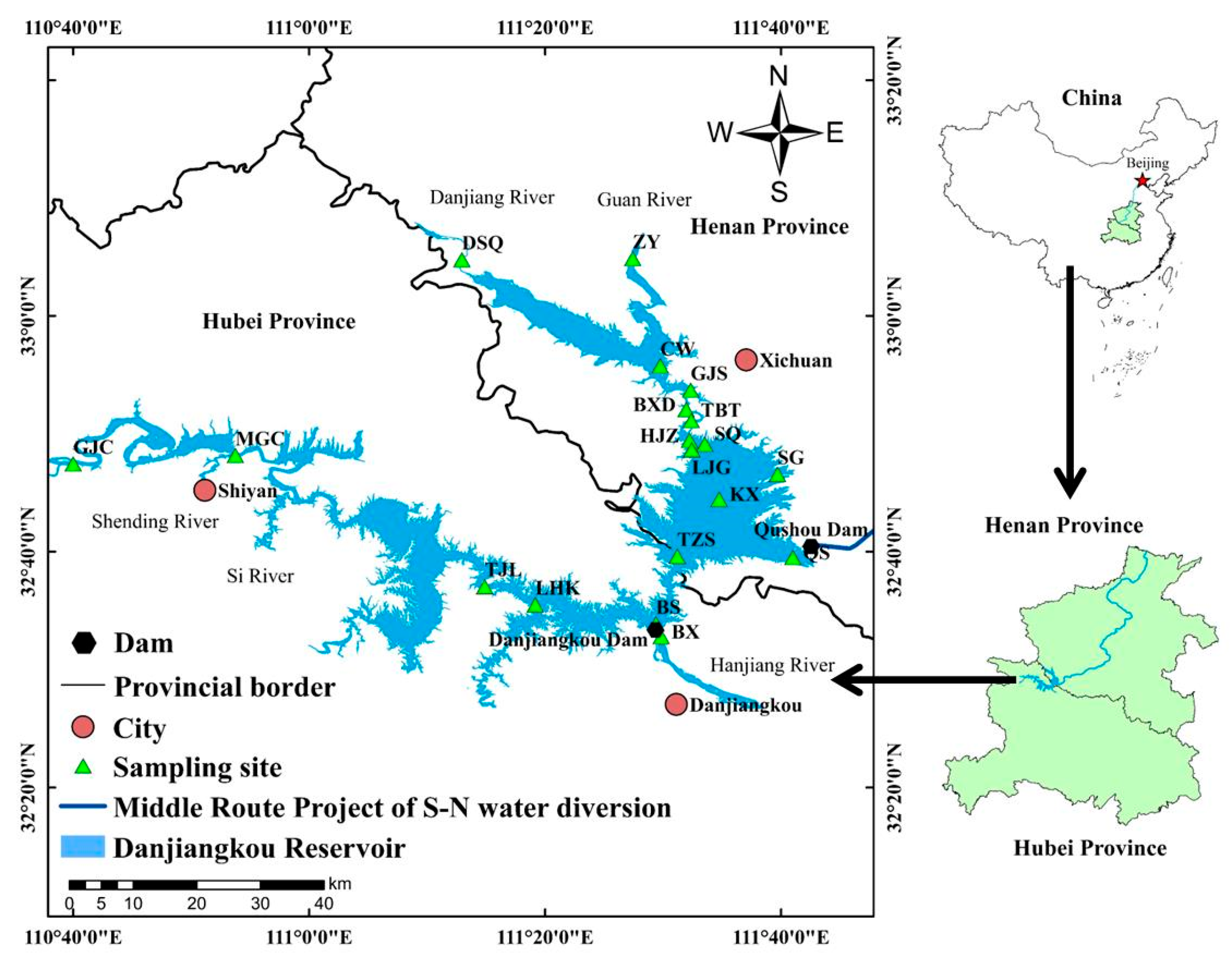
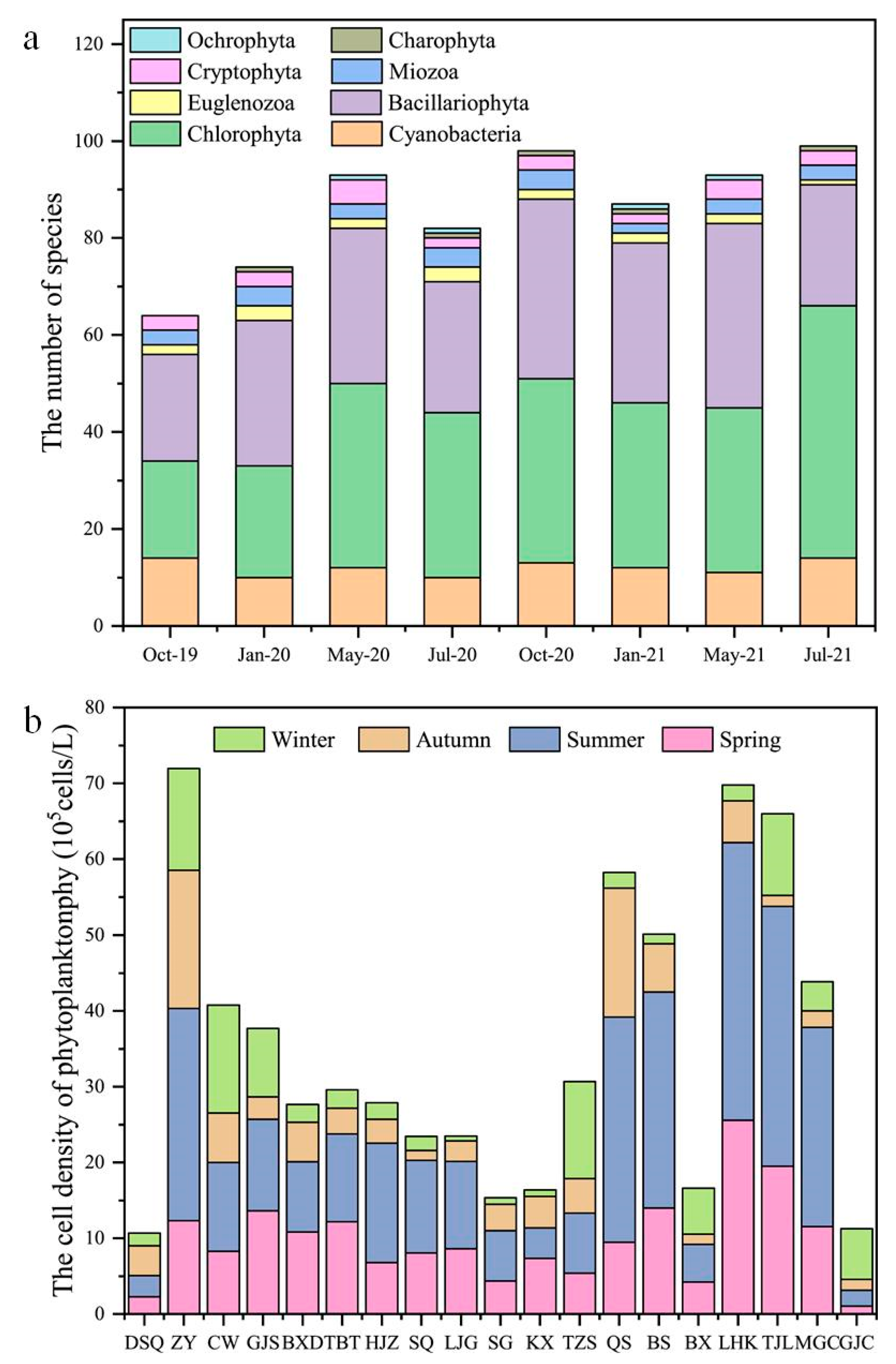
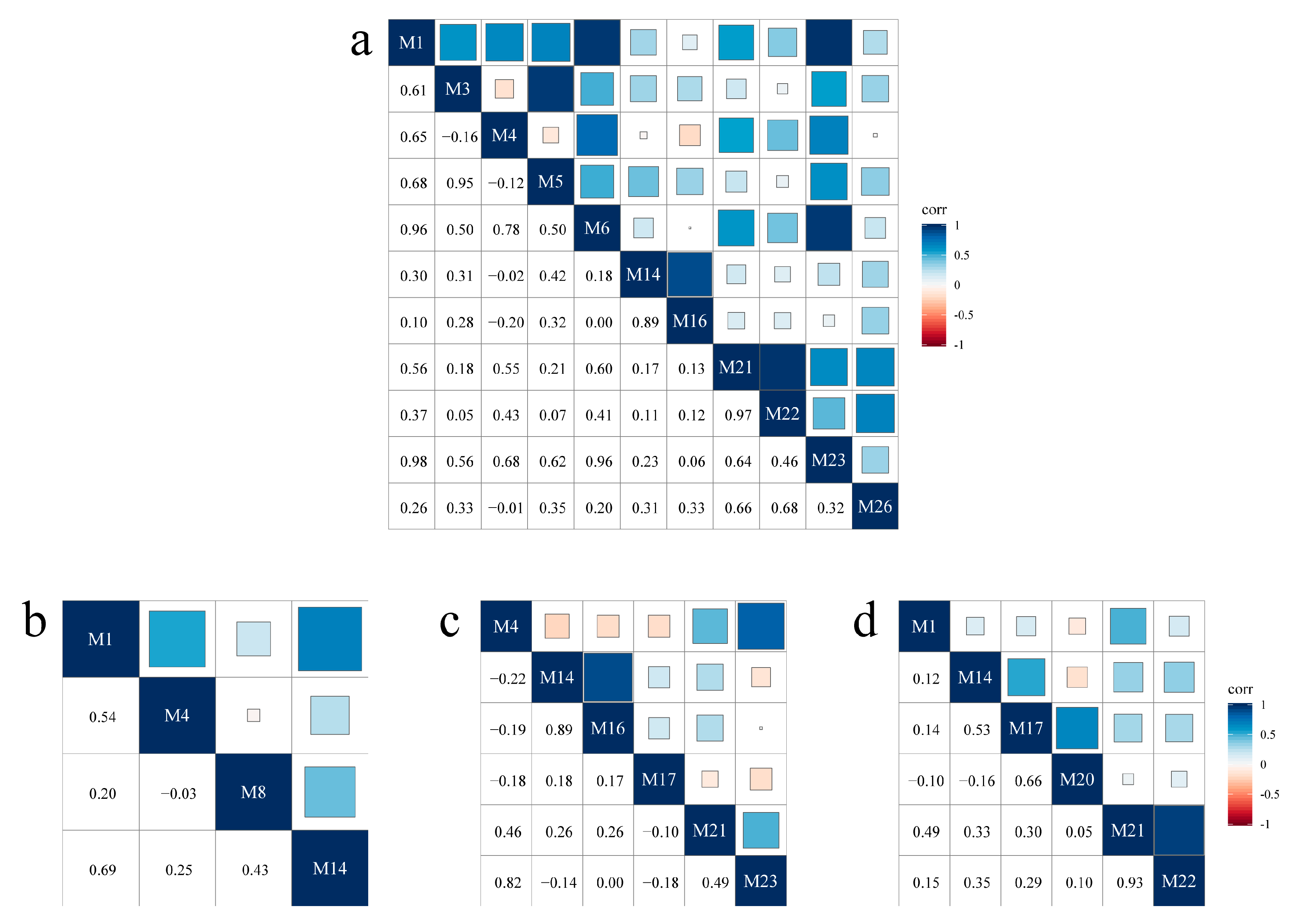
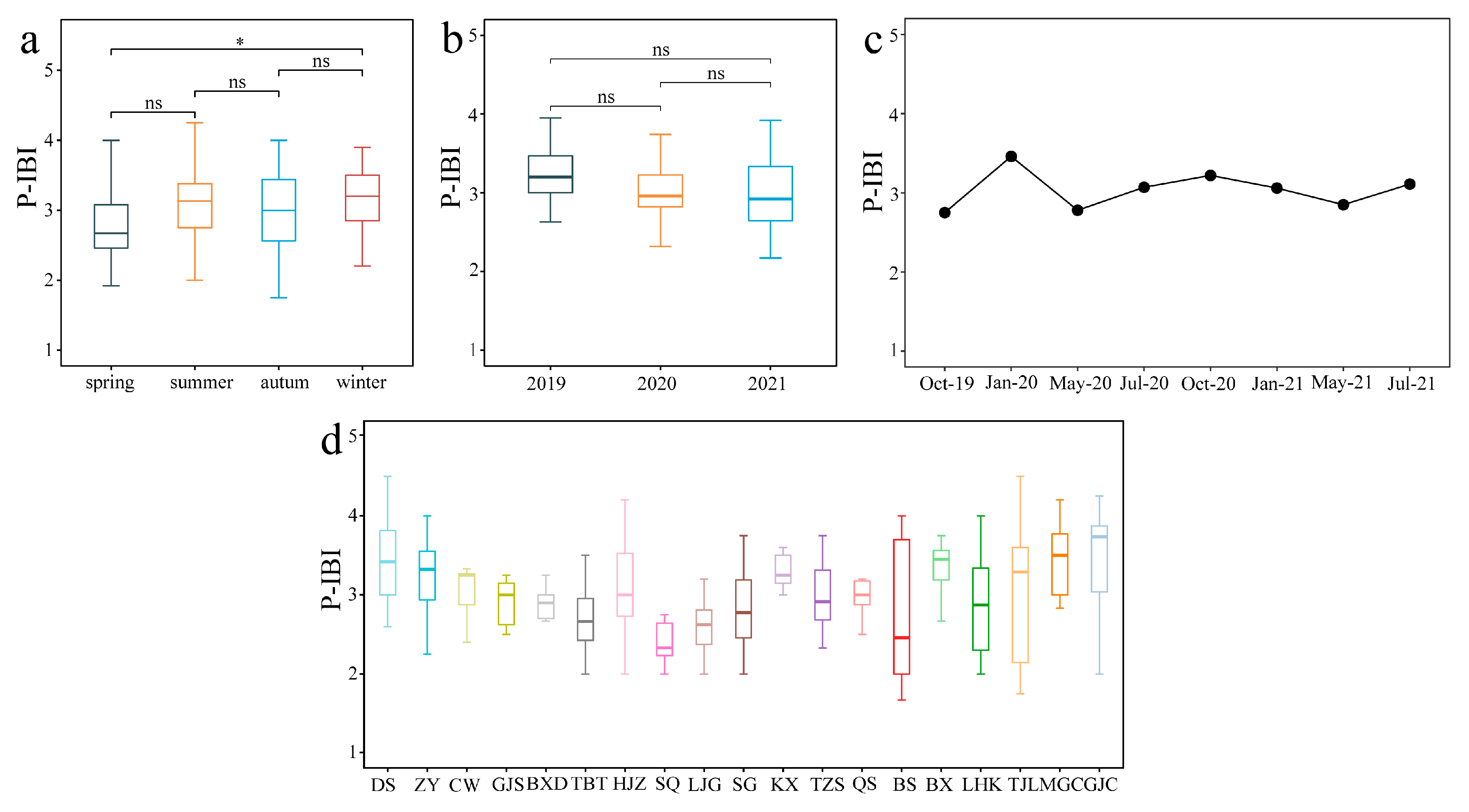
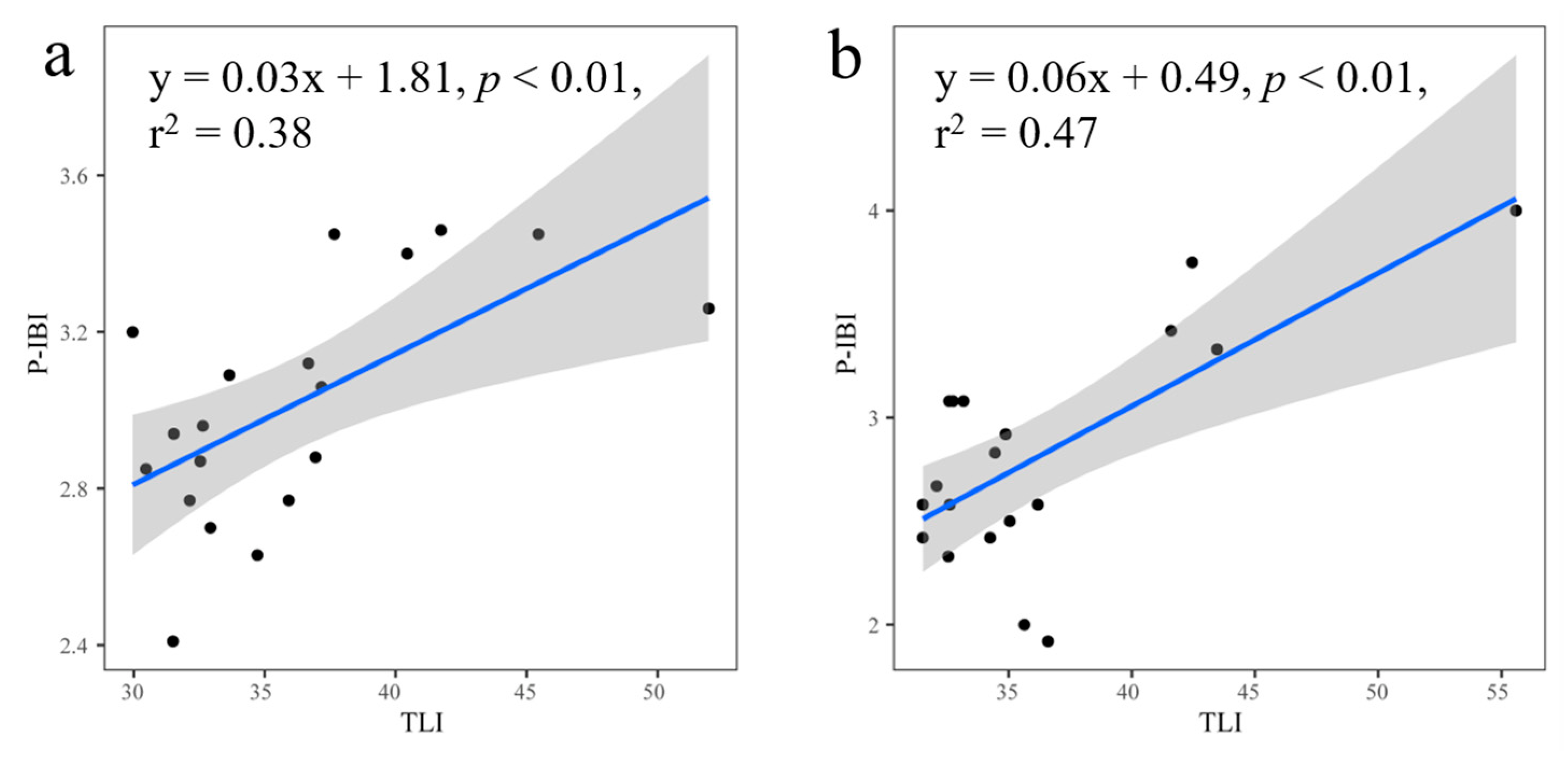
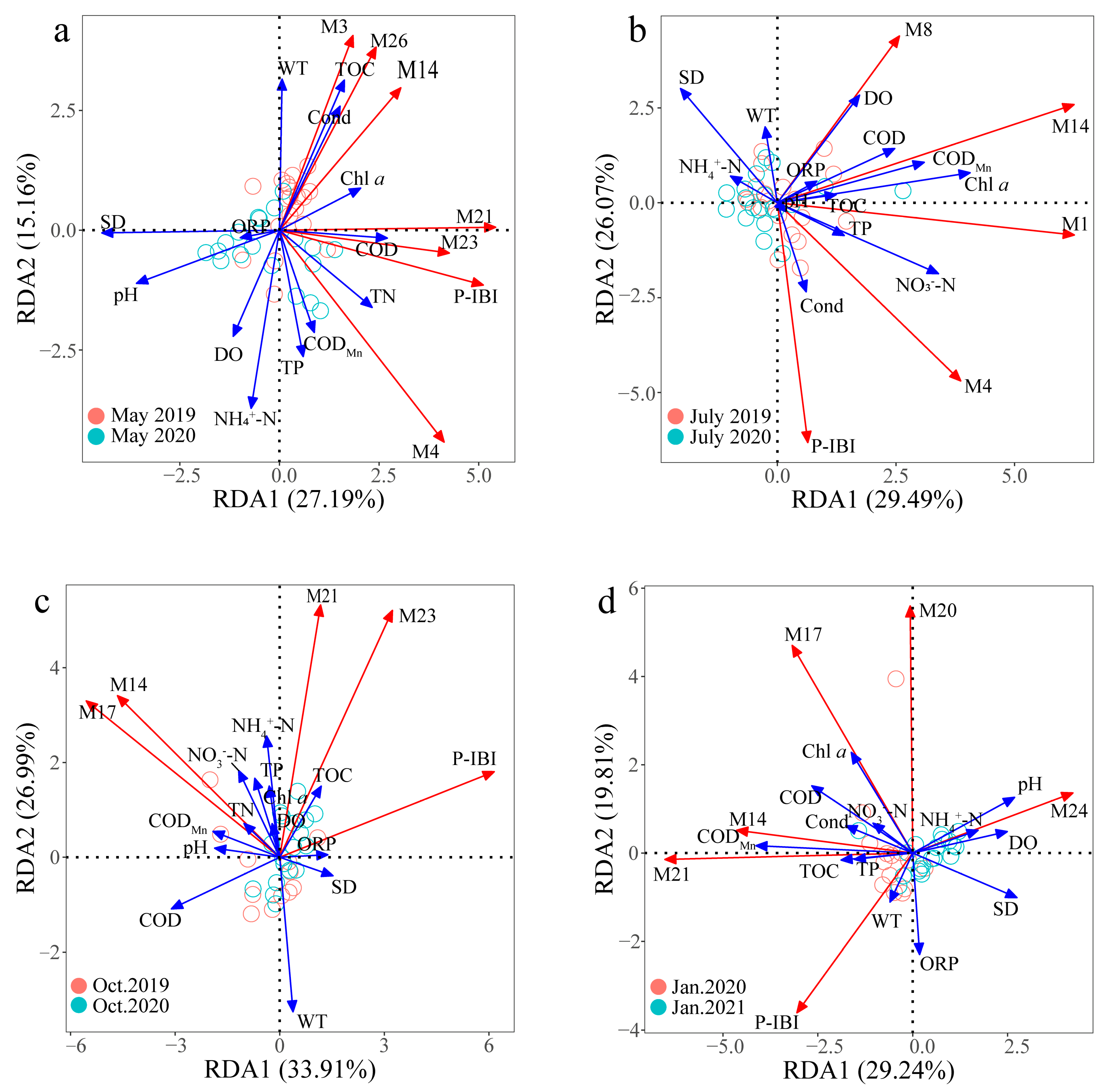
| Parameters | Spring | Summer | Autumn | Winter |
|---|---|---|---|---|
| WT (°C) | 22.19 ± 2.57 b | 28.69 ± 2.65 a | 21.79 ± 1.58 b | 11.23 ± 1.95 c |
| pH | 8.92 ± 0.26 a | 8.64 ± 0.35 b | 8.40 ± 0.16 c | 8.51 ± 0.14 b |
| DO (mg/L) | 9.04 ± 1.90 b | 9.43 ± 0.91 b | 7.41 ± 0.58 c | 11.00 ± 1.30 a |
| Cond (μS/cm) | 293.52 ± 66.08 a | 257.57 ± 76.33 a | 180.30 ± 79.02 bc | 219.31 ± 47.32 c |
| ORP (mV) | 110.80 ± 20.43 c | 165.51 ± 35.09 b | 206.71 ± 44.13 a | 149.3 8 ± 53.40 b |
| NO3−-N (mg/L) | 0.91 ± 0.43 | 1.03 ± 0.50 | 0.90 ± 0.39 | 0.95 ± 0.61 |
| NH4+-N (mg/L) | 0.28 ± 0.08 a | 0.27 ± 0.06 a | 0.11 ± 0.05 b | 0.08 ± 0.03 b |
| TN (mg/L) | 1.62 ± 0.87 | 1.80 ± 0.74 | 1.43 ± 0.57 | 1.41 ± 1.11 |
| TP (mg/L) | 0.02 ± 0.01 b | 0.04 ± 0.01 a | 0.02 ± 0.01 b | 0.02 ± 0.01 b |
| CODMn (mg/L) | 2.24 ± 0.41 b | 2.69 ± 0.78 a | 2.81 ± 0.88 a | 2.18 ± 0.59 b |
| TOC (mg/L) | 2.86 ± 0.61 a | 2.89 ± 0.72 a | 3.16 ± 0.83 a | 2.16 ± 1.41 b |
| SD (m) | 3.12 ± 1.57 | 2.86 ± 1.66 | 3.38 ± 1.60 | 2.60 ± 1.51 |
| COD (mg/L) | 9.81 ± 2.70 a | 10.44 ± 2.40 a | 5.32 ± 2.21 b | 5.43 ± 2.39 b |
| Season | Selected Multi-Metrics | Assigned Scores | ||||
|---|---|---|---|---|---|---|
| 5 | 4 | 3 | 2 | 1 | ||
| spring | M3 | >16.3 | 14–16.3 | 11.5–14 | 8.25–11.5 | <8.25 |
| M4 | >19.6 | 16–19.6 | 8.0–16 | 5.25–8 | <5.25 | |
| M14 | <0.29 | 0.29–0.51 | 0.51–0.67 | 0.67–1.11 | >1.11 | |
| M21 | >2.47 | 2.26–2.47 | 2.08–2.27 | 1.73–2.08 | <1.73 | |
| M23 | >2.84 | 2.56–2.84 | 2.07–2.56 | 1.88–2.07 | <1.88 | |
| M26 | <3.25 | 3.25–5 | 5.0–6.0 | 6–7.30 | >7.3 | |
| summer | M1 | >36 | 33–36 | 28–33 | 24.25–28 | <24.25 |
| M4 | >16.3 | 5.0–7.0 | 7–10.75 | 10.75–16.3 | <5 | |
| M8 | <7.96 | 7.96–43.1 | 43.1–87.58 | 87.58–190.04 | >190.04 | |
| M14 | <0.24 | 0.24–0.48 | 0.48–0.84 | 0.84–1.34 | >1.34 | |
| autumn | M14 | <0.54 | 0.27–0.54 | 0.16–0.27 | 0.11–0.16 | >3.00 |
| M17 | <0.04 | 0.07–0.04 | 0.04–0.10 | 0.10–0.14 | >0.14 | |
| M21 | >2.70 | 2.52–2.70 | 2.27–2.52 | 1.92–2.27 | >1.92 | |
| M23 | >3.31 | 2.44–3.31 | 1.98–2.44 | 1.3–1.98 | >1.3 | |
| winter | M14 | <0.05 | 0.05–0.09 | 0.09–0.14 | 1.15–0.14 | >1.15 |
| M17 | <0.04 | 0.04–0.07 | 0.07–0.11 | 0.11–0.31 | >0.31 | |
| M20 | <0.56 | 0.56–0.77 | 0.77–0.92 | 0.92–0.97 | >0.97 | |
| M21 | >2.36 | 2.17–2.36 | 1.91–2.17 | 1.19–1.91 | <1.19 | |
| M24 | <0.44 | 0.44–0.54 | 0.54–0.66 | 0.66–0.83 | >0.83 | |
Disclaimer/Publisher’s Note: The statements, opinions and data contained in all publications are solely those of the individual author(s) and contributor(s) and not of MDPI and/or the editor(s). MDPI and/or the editor(s) disclaim responsibility for any injury to people or property resulting from any ideas, methods, instructions or products referred to in the content. |
© 2023 by the authors. Licensee MDPI, Basel, Switzerland. This article is an open access article distributed under the terms and conditions of the Creative Commons Attribution (CC BY) license (https://creativecommons.org/licenses/by/4.0/).
Share and Cite
Qin, M.; Fan, P.; Li, Y.; Wang, H.; Wang, W.; Liu, H.; Messyasz, B.; Goldyn, R.; Li, B. Assessing the Ecosystem Health of Large Drinking-Water Reservoirs Based on the Phytoplankton Index of Biotic Integrity (P-IBI): A Case Study of Danjiangkou Reservoir. Sustainability 2023, 15, 5282. https://doi.org/10.3390/su15065282
Qin M, Fan P, Li Y, Wang H, Wang W, Liu H, Messyasz B, Goldyn R, Li B. Assessing the Ecosystem Health of Large Drinking-Water Reservoirs Based on the Phytoplankton Index of Biotic Integrity (P-IBI): A Case Study of Danjiangkou Reservoir. Sustainability. 2023; 15(6):5282. https://doi.org/10.3390/su15065282
Chicago/Turabian StyleQin, Mingqing, Panpan Fan, Yuying Li, Hongtian Wang, Wanping Wang, Han Liu, Beata Messyasz, Ryszard Goldyn, and Bailian Li. 2023. "Assessing the Ecosystem Health of Large Drinking-Water Reservoirs Based on the Phytoplankton Index of Biotic Integrity (P-IBI): A Case Study of Danjiangkou Reservoir" Sustainability 15, no. 6: 5282. https://doi.org/10.3390/su15065282





